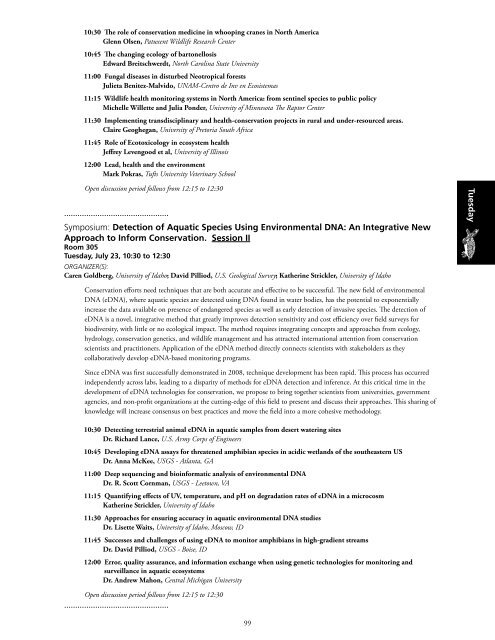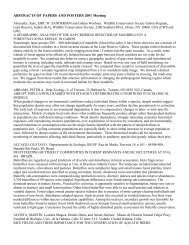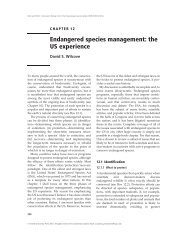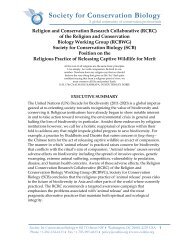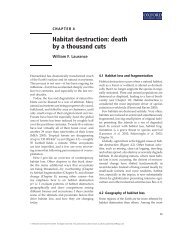ICCB 2013 Program - Society for Conservation Biology
ICCB 2013 Program - Society for Conservation Biology
ICCB 2013 Program - Society for Conservation Biology
You also want an ePaper? Increase the reach of your titles
YUMPU automatically turns print PDFs into web optimized ePapers that Google loves.
10:30 The role of conservation medicine in whooping cranes in North America<br />
Glenn Olsen, Patuxent Wildlife Research Center<br />
10:45 The changing ecology of bartonellosis<br />
Edward Breitschwerdt, North Carolina State University<br />
11:00 Fungal diseases in disturbed Neotropical <strong>for</strong>ests<br />
Julieta Benitez-Malvido, UNAM-Centro de Inv en Ecosistemas<br />
11:15 Wildlife health monitoring systems in North America: from sentinel species to public policy<br />
Michelle Willette and Julia Ponder, University of Minnesota The Raptor Center<br />
11:30 Implementing transdisciplinary and health-conservation projects in rural and under-resourced areas.<br />
Claire Geoghegan, University of Pretoria South Africa<br />
11:45 Role of Ecotoxicology in ecosystem health<br />
Jeffrey Levengood et al, University of Illinois<br />
12:00 Lead, health and the environment<br />
Mark Pokras, Tufts University Veterinary School<br />
Open discussion period follows from 12:15 to 12:30<br />
...............................................<br />
Symposium: Detection of Aquatic Species Using Environmental DNA: An Integrative New<br />
Approach to In<strong>for</strong>m <strong>Conservation</strong>. Session II<br />
Room 305<br />
Tuesday, July 23, 10:30 to 12:30<br />
Organizer(s):<br />
Caren Goldberg, University of Idaho; David Pilliod, U.S. Geological Survey; Katherine Strickler, University of Idaho<br />
Tuesday<br />
<strong>Conservation</strong> ef<strong>for</strong>ts need techniques that are both accurate and effective to be successful. The new field of environmental<br />
DNA (eDNA), where aquatic species are detected using DNA found in water bodies, has the potential to exponentially<br />
increase the data available on presence of endangered species as well as early detection of invasive species. The detection of<br />
eDNA is a novel, integrative method that greatly improves detection sensitivity and cost efficiency over field surveys <strong>for</strong><br />
biodiversity, with little or no ecological impact. The method requires integrating concepts and approaches from ecology,<br />
hydrology, conservation genetics, and wildlife management and has attracted international attention from conservation<br />
scientists and practitioners. Application of the eDNA method directly connects scientists with stakeholders as they<br />
collaboratively develop eDNA-based monitoring programs.<br />
Since eDNA was first successfully demonstrated in 2008, technique development has been rapid. This process has occurred<br />
independently across labs, leading to a disparity of methods <strong>for</strong> eDNA detection and inference. At this critical time in the<br />
development of eDNA technologies <strong>for</strong> conservation, we propose to bring together scientists from universities, government<br />
agencies, and non-profit organizations at the cutting-edge of this field to present and discuss their approaches. This sharing of<br />
knowledge will increase consensus on best practices and move the field into a more cohesive methodology.<br />
10:30 Detecting terrestrial animal eDNA in aquatic samples from desert watering sites<br />
Dr. Richard Lance, U.S. Army Corps of Engineers<br />
10:45 Developing eDNA assays <strong>for</strong> threatened amphibian species in acidic wetlands of the southeastern US<br />
Dr. Anna McKee, USGS - Atlanta, GA<br />
11:00 Deep sequencing and bioin<strong>for</strong>matic analysis of environmental DNA<br />
Dr. R. Scott Cornman, USGS - Leetown, VA<br />
11:15 Quantifying effects of UV, temperature, and pH on degradation rates of eDNA in a microcosm<br />
Katherine Strickler, University of Idaho<br />
11:30 Approaches <strong>for</strong> ensuring accuracy in aquatic environmental DNA studies<br />
Dr. Lisette Waits, University of Idaho, Moscow, ID<br />
11:45 Successes and challenges of using eDNA to monitor amphibians in high-gradient streams<br />
Dr. David Pilliod, USGS - Boise, ID<br />
12:00 Error, quality assurance, and in<strong>for</strong>mation exchange when using genetic technologies <strong>for</strong> monitoring and<br />
surveillance in aquatic ecosystems<br />
Dr. Andrew Mahon, Central Michigan University<br />
Open discussion period follows from 12:15 to 12:30<br />
...............................................<br />
99


